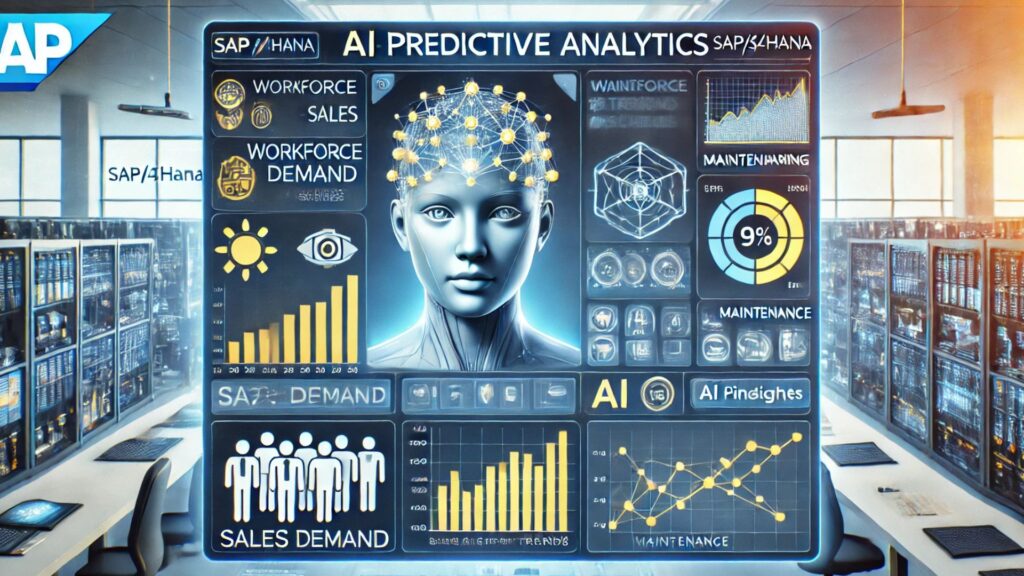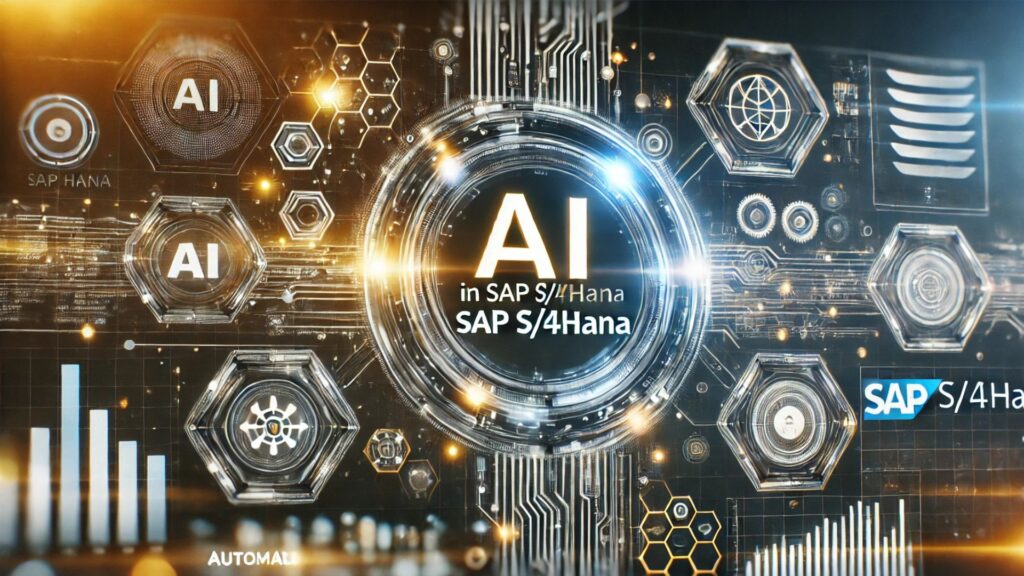Unlocking the Power of AI in SAP S/4HANA
Unlocking the Power of AI in SAP S/4HANA
Intelligent Automation, Smarter Workflows, and Future Innovations
AI as a Game-Changer for SAP S/4HANA
Artificial Intelligence (AI) is rapidly transforming enterprise resource planning (ERP) systems, and SAP S/4HANA is at the forefront of this evolution. By embedding AI-driven automation, predictive analytics, and conversational interfaces, SAP is redefining how businesses manage operations, make decisions, and interact with their ERP systems. As companies navigate an increasingly complex business landscape, AI offers a way to streamline processes, reduce manual effort, and improve decision-making with real-time insights.
The need for intelligent automation in business processes has never been greater. Traditional ERP systems have long depended on structured workflows, predefined rules, and manual data entry, making them efficient but often rigid. AI changes this paradigm by introducing self-learning algorithms, automated data processing, and predictive analytics that can anticipate needs before users even realize them. Whether optimizing supply chain logistics, automating financial reconciliations, or personalizing customer interactions, AI-infused ERP systems enable businesses to become more agile, proactive, and efficient.
SAP has made a firm commitment to embedding AI into its core S/4HANA platform. The introduction of capabilities such as predictive labor planning, AI-assisted financial processing, and SAP Joule, the new digital assistant, demonstrates SAP’s ambition to create an intelligent ERP ecosystem. With these enhancements, SAP aims to help organizations not just digitize their processes but intelligently automate them, making enterprise workflows more seamless and reducing the friction associated with traditional ERP tasks.
The impact of AI in SAP S/4HANA extends beyond efficiency gains—it fundamentally shifts how businesses operate. AI-powered automation reduces the need for repetitive tasks, allowing employees to focus on strategic initiatives. Predictive analytics offers deep insights into trends, helping organizations mitigate risks and seize opportunities more effectively. Meanwhile, AI-driven collaboration tools are making it easier for employees to work within their existing enterprise ecosystem, integrating with platforms like Microsoft Teams to facilitate faster decision-making.
As SAP continues to evolve its AI capabilities, organizations that embrace these changes early will gain a competitive edge. The question is no longer whether businesses should adopt AI, but rather how quickly they can integrate AI-driven tools into their SAP S/4HANA environment.

Key AI Capabilities in SAP S/4HANA Today
SAP S/4HANA has evolved beyond traditional ERP capabilities, embedding AI into its core to optimize processes, enhance decision-making, and improve user experience. By integrating predictive analytics, machine learning, automation, and conversational AI, SAP enables businesses to operate more efficiently while reducing manual effort and increasing accuracy. These AI-driven enhancements empower organizations to anticipate future trends, automate routine processes, and facilitate more intuitive interactions with their ERP system.
Predictive Analytics and Machine Learning
One of the most impactful AI advancements in SAP S/4HANA is the integration of predictive analytics and machine learning to improve forecasting and planning. In areas like workforce management, AI-powered Predictive Labor Demand Planning enables businesses to anticipate labor requirements based on historical data, seasonal trends, and operational patterns. This allows organizations to optimize workforce allocation, reducing inefficiencies and ensuring sufficient staffing levels for critical tasks.
AI also plays a crucial role in predictive maintenance, an essential capability for asset-intensive industries. By analyzing sensor data and historical maintenance records, SAP S/4HANA can forecast equipment failures before they happen, reducing downtime and minimizing maintenance costs. Businesses can shift from reactive to proactive maintenance, extending the lifespan of machinery and improving operational resilience.
AI-driven sales and inventory predictions further enhance decision-making across supply chain and procurement processes. By analyzing past purchasing behaviors, customer demand, and external market trends, SAP S/4HANA enables companies to optimize inventory levels and prevent overstocking or shortages. This predictive capability reduces waste, improves cash flow, and ensures that stock levels align with real demand.
AI-Driven Business Process Automation
SAP S/4HANA embeds AI-driven automation to streamline financial processes, document handling, and operational workflows. AI-assisted journal uploads simplify period-end closing tasks by analyzing historical financial data and pre-populating journal entries, reducing manual effort and minimizing errors. Accountants and finance teams can focus on higher-value activities instead of spending excessive time on transactional tasks.
Another significant advancement is AI-powered document processing, which eliminates manual data entry by leveraging AI-based optical character recognition (OCR) and natural language processing (NLP). This capability allows SAP S/4HANA to extract and validate information from invoices, contracts, and forms, automating workflows that traditionally required extensive human intervention. By reducing processing time and improving accuracy, businesses can achieve faster approvals and better compliance with financial and regulatory requirements.
In supply chain and production planning, SAP’s AI-based scheduling optimizes resource allocation by analyzing constraints, demand fluctuations, and external factors such as supplier lead times. AI-enhanced planning tools help businesses dynamically adjust schedules, ensuring that materials, labor, and equipment are aligned with production needs. This level of automation reduces waste, prevents bottlenecks, and enables a more responsive supply chain.
Conversational AI and User Experience
SAP has introduced SAP Joule, a digital AI assistant, to simplify user interactions and provide real-time insights. Joule leverages natural language processing (NLP) and AI-driven recommendations to help users navigate SAP S/4HANA, retrieve information, and automate routine tasks. By allowing employees to interact with the ERP system in a conversational manner, SAP Joule reduces the complexity of system navigation and improves productivity.
SAP’s broader use of NLP enhances user experience by making data retrieval and system interaction more intuitive. Employees can ask questions in natural language—such as, "What were last quarter’s revenue figures?"—and receive immediate, AI-generated responses. This capability reduces the need for manual searches and enables faster decision-making.
By embedding predictive analytics, business process automation, and conversational AI, SAP S/4HANA delivers an intelligent, adaptive ERP environment. These capabilities help organizations move from reactive decision-making to proactive, AI-driven operations, setting the foundation for greater agility and efficiency in the modern enterprise.
Extending AI in SAP S/4HANA
AI in SAP S/4HANA is not limited to internal system automation and predictive insights. For AI to deliver its full potential, it must also improve collaboration, decision-making, and workflow execution across enterprise applications. This is where integration with Microsoft Teams and Looply becomes a game-changer, bringing AI-driven SAP processes directly into a collaborative, real-time environment.
SAP recognizes that modern business processes often involve multiple stakeholders who need to interact with SAP data in real time. Traditional ERP workflows typically rely on emails, approvals in SAP inboxes, and manual follow-ups, which slow down decision-making and introduce inefficiencies. By extending SAP’s AI capabilities into Microsoft Teams, businesses can break down these silos, enabling faster, AI-powered approvals and notifications where employees already collaborate.
Looply enhances this integration by enabling intelligent workflows within Microsoft Teams. As an SAP-connected platform, Looply ensures that approvals, notifications, and business-critical decisions are surfaced in Teams, allowing users to take action instantly. AI can be embedded within Looply to prioritize, analyze, summarize, and suggest responses for SAP process approvals, reducing administrative overhead and increasing efficiency.
AI-driven decision-making in SAP S/4HANA is particularly valuable in high-risk and high-value business processes. In finance, AI can detect anomalies in invoices and payments, helping teams reduce fraud risks and ensure compliance before approving transactions. In procurement, AI-assisted approvals can flag suppliers with inconsistent delivery records or suggest alternative vendors based on past performance. AI-powered master data notifications ensure that stakeholders are alerted to key changes in supplier or customer information, preventing data quality issues from escalating.
The Future of AI in SAP S/4HANA
SAP's integration of artificial intelligence (AI) into S/4HANA signifies a transformative shift toward intelligent, self-optimizing enterprise systems. As AI capabilities advance, businesses leveraging SAP S/4HANA can anticipate more sophisticated predictive analytics, decision-making automation, and enhanced user experiences powered by generative AI and large language models. SAP's commitment to embedding AI across its portfolio is evident, with plans to deliver over 400 AI use cases by the end of 2025, positioning SAP Business AI as a leader in the industry.
A cornerstone of SAP's AI strategy is SAP Joule, an AI assistant designed to revolutionize user interaction with enterprise applications. Launched in September 2023, Joule leverages generative AI to provide intelligent insights through natural language processing, integrating seamlessly with SAP's suite of solutions and third-party data sources. This integration aims to enhance decision-making and operational efficiency within organizations.
In future iterations, SAP Joule is expected to evolve into a proactive AI assistant that not only provides insights but also undertakes complex problem-solving tasks. Instead of merely responding to queries, Joule will autonomously generate reports, recommend process optimizations, and draft business documents based on ERP data, thereby reducing the cognitive load on employees and allowing them to focus on strategic decision-making.
Beyond internal automation, AI's role in SAP S/4HANA is expanding to encompass external-facing interactions with customers and suppliers. Advanced AI-driven chatbots are being developed to offer context-aware recommendations and automate service requests. For instance, suppliers might interact with AI-powered self-service portals capable of predicting future purchase orders, suggesting pricing adjustments, and autonomously handling disputes, thereby minimizing manual intervention in procurement processes.
SAP's AI strategy also emphasizes industry-specific innovations, tailoring AI applications to various sectors such as manufacturing, healthcare, retail, and financial services. In manufacturing, AI-driven production planning is anticipated to become more adaptive and self-correcting, responding in real-time to fluctuations in demand and raw material availability. In healthcare, AI-powered ERP solutions are expected to enhance patient data management and predictive diagnostics, contributing to more intelligent hospital operations.
Ultimately, the future of AI in SAP S/4HANA is about transitioning from automation to autonomy. Businesses that embrace these advancements early are likely to position themselves at the forefront of digital transformation, leveraging AI not just as a tool for efficiency but as a strategic driver of competitive advantage.
Implementing AI in SAP: Best Practices for Businesses
As AI capabilities in SAP S/4HANA continue to expand, businesses must adopt a structured approach to AI implementation to maximize benefits. Successfully integrating AI requires careful planning, high-quality data, and a clear strategy to align AI-driven automation with business objectives. Organizations that proactively adopt AI will be better positioned to enhance operational efficiency, reduce manual effort, and drive innovation.
One of the first steps in AI adoption is ensuring clean and structured data. AI models are only as good as the data they are trained on, and poor data quality can lead to inaccurate predictions and unreliable automation.
Businesses should prioritize data governance frameworks that include real-time validation, automated cleansing, and AI-driven anomaly detection to ensure that AI tools receive accurate and relevant information. SAP S/4HANA already provides built-in data management capabilities, but organizations must still invest in master data management (MDM) practices to maintain consistency across financial, procurement, and supply chain systems.
To accelerate AI adoption, businesses should leverage embedded AI tools within SAP S/4HANA rather than building custom AI models from scratch. SAP’s predictive analytics, machine learning, and AI-driven automation features are designed to seamlessly integrate with enterprise workflows. For example, AI-assisted journal uploads simplify financial processes by learning from past entries, reducing manual reconciliation efforts. Similarly, predictive maintenance models in SAP S/4HANA monitor asset performance and recommend proactive interventions to prevent costly downtime. Organizations should first explore these native AI functionalities before considering external AI solutions.
Another key consideration is the integration of AI-powered collaboration tools. AI is not just about automation—it also enhances human decision-making by surfacing insights where they are needed most. By bridging SAP and Microsoft Teams with AI-powered tools like Looply, businesses can ensure that AI-driven insights and approval workflows reach decision-makers in real time. For example, AI-powered approval workflows can detect anomalies in procurement requests, highlight potential risks, and suggest corrective actions—all within Microsoft Teams, eliminating the need to log into multiple systems.
Despite AI’s potential, organizations often encounter challenges in AI implementation, including resistance to change, lack of AI expertise, and concerns about data privacy. To overcome these barriers, businesses should adopt a phased AI deployment strategy, starting with low-risk, high-impact AI use cases such as invoice automation or predictive analytics for demand planning. Early success in these areas builds confidence and provides valuable insights that can be applied to more complex AI initiatives. Additionally, training employees to work alongside AI systems is crucial—AI should be seen as an enhancement rather than a replacement for human expertise.
AI adoption in SAP S/4HANA is not a one-time implementation but an ongoing journey. Organizations should continuously evaluate AI performance, refine algorithms, and stay updated on SAP’s AI roadmap to take advantage of new features as they become available. As AI evolves, businesses that embrace AI as a core component of their digital strategy will gain a competitive advantage, improving both operational efficiency and strategic decision-making.

Why AI is the Future of SAP S/4HANA
AI is no longer an emerging trend—it is a fundamental driver of efficiency, automation, and decision-making in enterprise software. As SAP continues to embed AI into S/4HANA, businesses that embrace these advancements will gain a competitive edge by operating with greater agility, accuracy, and intelligence. AI is not just about automating repetitive tasks; it is about enhancing enterprise processes, optimizing resources, and enabling data-driven decision-making at an unprecedented scale.
The strategic benefits of AI in SAP S/4HANA extend beyond operational efficiency. AI-powered predictive analytics improves demand forecasting, inventory management, and financial planning, reducing risks and maximizing business outcomes. Machine learning models embedded within SAP processes help organizations detect anomalies, prevent fraud, and automate routine approvals, freeing employees to focus on high-value work. Conversational AI, like SAP Joule, enhances the user experience by making ERP interactions more intuitive and accessible, reducing reliance on complex navigation and manual searches.
The integration of AI-driven workflows into collaborative platforms like Microsoft Teams, enabled by tools such as Looply, further amplifies the power of AI in enterprise environments. By bringing AI-powered approvals and notifications into everyday collaboration spaces, businesses reduce process bottlenecks and accelerate decision-making. AI-driven insights ensure that critical business processes are not only automated but also contextually intelligent, assisting decision-makers with real-time recommendations.
As SAP advances its AI roadmap, future iterations of SAP S/4HANA will continue to refine and expand AI capabilities, moving from automation to true cognitive decision-making. Businesses that stay ahead of these developments will benefit from AI-driven process optimization, greater resilience in supply chains, and enhanced financial intelligence. AI will increasingly become a proactive partner in enterprise operations, predicting challenges before they arise and enabling organizations to act with speed and precision.
For organizations still hesitating to implement AI in SAP S/4HANA, the question is no longer if they should adopt AI, but how quickly they can leverage it to gain business value. Those who move early will not only see immediate improvements in efficiency but also future-proof their operations for the next generation of intelligent enterprise software. AI is not just the future of SAP S/4HANA—it is the key to unlocking a smarter, faster, and more adaptive enterprise.



